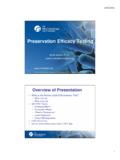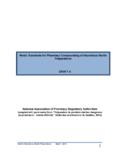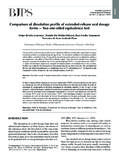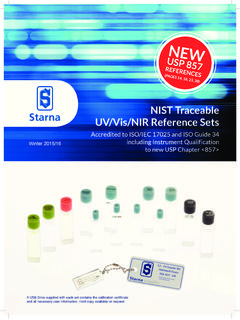Transcription of Comparison of pharmacopeial statistical methods applied in ...
1 *Correspondence: M. F. V. Leonel. Departamento de Produtos Farmac uticos, Faculdade de Farm cia UFMG. Av. Pres. Ant nio Carlos, 6627 - Pampulha - 31270-901 - Belo Horizonte - MG, Brasil. E-mail: Journal of Pharmaceutical Sciencesvol. 48, n. 3, , 2012 Comparison of pharmacopeial statistical methods applied in microbiological assay for antibiotics potency determination using parallel lines and three-dose levelMiriam de F tima Vianna Leonel*1, Cristina Duarte Vianna Soares1, Arminda Lucia Siqueira2 1 Department of Pharmaceutical Products, Faculty of Pharmacy, Federal University of Minas Gerais, Brazil; 2 Department of Statistics, Federal University of Minas GeraisPharmaceutical equivalence studies, useful for checking the interchangeability of generic medicines and their respective innovator medicines, have been carried out in Brazil since 1999, as a consequence of the establishment of the generic medicine policy.
2 For medicines containing antibiotics, microbiological assays are often the most appropriate method. However, the statistical methods applied in these assays are not widely known due to the difficult access to official codes and/or little knowledge of the statistical tools of analysis. Thus, the aim of this work was to compare the statistical methods for determining the potency of antibiotics through the cylinder-plate method using parallel lines and a three-dose level model, as described in the Brazilian Pharmacopeia (4th edition, 1988), British Pharmacopoeia 2011, European Pharmacopoeia (7th edition), The International Pharmacopoeia (4th edition), and United States Pharmacopeia (34th edition). The assay is illustrated with the antibiotic ofloxacin, and details on orthogonal coefficients, normality test, homogeneity of variance test, and detection of outliers are discussed.
3 The calculations obtained by statistical analyses from different pharmacopeias lead to the same final interpretation. In practice, with the availability of alternative pharmacopeial methods , the analyst can choose the most appropriate statistical calculation to be : Antibiotics/potency. Parallel lines model. pharmacopeial statistical estudos de equival ncia farmac utica, teis na verifica o da intercambialidade entre os medicamentos gen ricos e respectivos medicamentos de refer ncia, t m sido realizados no Brasil desde 1999, como consequ ncia do estabelecimento da pol tica de medicamentos gen ricos. Para medicamentos contendo antibi ticos, os ensaios microbiol gicos s o, muitas vezes, o m todo mais adequado. Entretanto, os m todos estat sticos aplicados nesses ensaios n o s o amplamente conhecidos devido dificuldade de acesso aos comp ndios oficiais e/ou pouca compreens o das ferramentas estat sticas de an lises.
4 Portanto, o objetivo desse trabalho foi comparar os m todos estat sticos para determina o de pot ncia de antibi ticos pelo delineamento por retas paralelas e tr s n veis de doses, descritos nas farmacopeias Brasileira 4. ed. (1988), Brit nica 2011, Europeia 7. ed., Internacional 4. ed. e na Farmacopeia dos Estados Unidos 34. ed. (2011). O ensaio exemplificado com o antibi tico ofloxacino e detalhes sobre coeficientes ortogonais, teste de normalidade, teste de homogeneidade de vari ncia e detec o de outliers s o discutidos. Os c lculos obtidos pelas an lises estat sticas segundo as diferentes farmacopeias resultaram na mesma interpreta o final. Na pr tica, m todos farmacop icos alternativos permitem ao analista a escolha do c lculo estat stico mais apropriado a ser : Antibi ticos/pot ncia.
5 Delineamento por retas paralelas. M todos estat sticos farmacop F. V. Leonel, C. D. V. Soares, A. L. Siqueira566 INTRODUCTIONM icrobiological assays on antibiotics are used in pharmaceutical preparations and raw materials whose contents are related to their biological activity and usually cannot be determined by chemical analyses. Typically, antibiotic drugs have their potency determined by com-parison with a standard substance or a biological reference substance. Such potency is expressed as the ratio of the dose that inhibits the growth of a sensitive microorgan-ism, relative to the standard substance dose that produces similar inhibition. The agar diffusion or cylinder-plate method used consists of a dose-response model in which the antibiotic concentration is proportional to the inhibi-tion zone of microorganism statistical analysis of such experiments re-quires the establishment of a mathematical relationship of the mean responses (y) with the crescent concentra-tions (treatments or doses) of the antibiotic.
6 The most commonly used model is the parallel lines, in which every reference standard (S) and unknown (U) prepara-tion should be tested with the same number of doses. Normally, two or three doses per preparation are used, and the ratio of adjacent doses should be constant for all treatments of the potency calculation is based, in this case, on the analysis of two straight lines, one referring to the standard responses and the other to the unknown responses. They are obtained by the relationship between their responses and the decimal logarithm (log10) or natural logarithm (ln) of each of the doses (Hewitt, 2004; British Pharmacopoeia, 2011; European Pharmacopoeia, 2011). The least squares method (Farias et al., 2003) is most commonly used to check the linearity of the curves, and, therefore, the same number of reference standard and unknown responses is used (S1, S2, S3, and U1, U2, U3).
7 This method is still based on the assumption that the responses (y) follow the nor-mal distribution (Gaddum, 1953; Farmacopeia Brasileira, 1988; British Pharmacopoeia, 2011; European Pharmaco-poeia, 2011) and have a constant variance (Farmacopeia Brasileira, 1988; British Pharmacopoeia, 2011; European Pharmacopoeia, 2011), and the errors are independent (random) (Farmacopeia Brasileira, 1988).Evaluating these experiments involves the applica-tion of statistical calculations currently described in phar-macopeias. However, these calculations are not understood by analysts, primarily due to the unavailability of official codes in the pharmaceutical industries. Moreover, a lack of specialists in the area, together with little knowledge of the statistical tools of analysis, has also been observed.
8 Thus, an investment in qualified personnel is extremely important for the pharmaceutical industry. The success of the experimental antibiotics assay design requires a knowl-edge of various pharmacopeial methods , a familiarity with statistical hypothesis testing, and a correct interpretation of the validity parameters. It is worth emphasizing that microbiological assays of antibiotics are performed, among others, in studies of pharmaceutical equivalence for registration or renewal of generic medicines. In Brazil, with the advent of the generic drug policy established in 1999, the regulatory agency admits many foreign pharma-ceutical codes as official references for the quality control of raw materials and pharmaceuticals, in the absence of a monograph in the Brazilian Pharmacopeia.
9 Normality testA test to check the normality of the response variable (y) is recommended in the British Pharmacopoeia (BP) (British Pharmacopoeia, 2011), European Pharmacopoeia (EP) (European Pharmacopoeia, 2011), Brazilian Pharma-copeia (FB) (Farmacopeia Brasileira, 1988), International Pharmacopoeia (IP) (The International Pharmacopoeia, 2011), and United States Pharmacopeia (USP 34) (United States Pharmacopeia, 2011). In BP and EP, the work by Shapiro and Wilk is recommended (Shapiro, Wilk, 1965) for verification of the test and the calculations. Consider y1 < y2 < ..< yn the ordered sample responses of size n in which i = 1, 2, .., n and y1 is the smallest value. The statistic is defined as . (1)The constant b is calculated by , (2)in which ai is tabulated (for n 50) in the referred cita-tion.
10 For normal distribution, the value of W should be close to test of normality is known as Anderson-Darling (AD) (Minitab, 2010), which is not mentioned in the pharmacopeias. It is based on the cumulative distribu-tion function (cdf) of the empirical data to be analyzed. In the calculation, the weighted quadratic distance is used between the line adjusted of the probability plot (based on the selected distribution) and nonparametric function. The statistic is defined as, (3)in which F is the cumulative distribution function of the Comparison of pharmacopeial statistical methods applied in microbiological assay for antibiotics potency determination567normal distribution of the response yi sorted in ascending a scale from 0 to 1, a small AD value indicates that normal distribution fits best the data.















